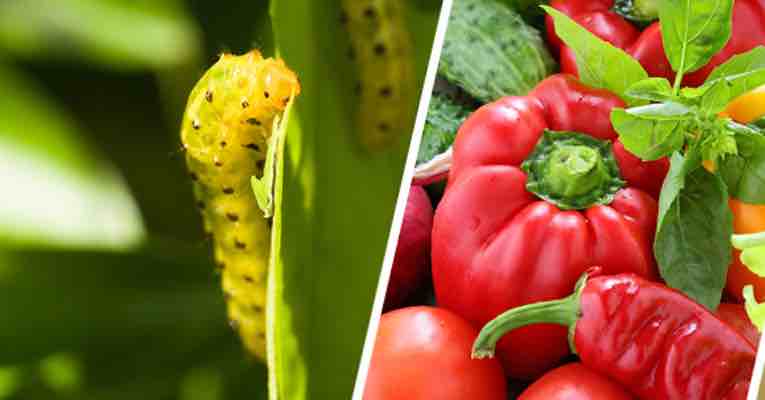



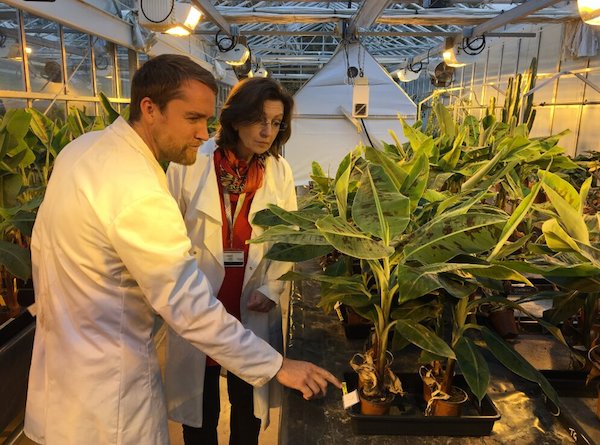

By Mathew Reynolds, Wheat Physiologist at, CIMMYT
First post of our “Global Collaboration” series
Wheat is the most widely grown crop in the world, currently providing about 20 percent of human calorie consumption. However, demand is predicted to increase by 60 percent within just 30 years, while long-term climate trends threaten to reduce wheat productivity, especially in less developed countries.
For over half a century, the International Wheat Improvement Network (IWIN), coordinated by CIMMYT, has been a global leader in breeding and disseminating improved wheat varieties to combat this problem, with a major focus on the constraints of resource poor farmers.
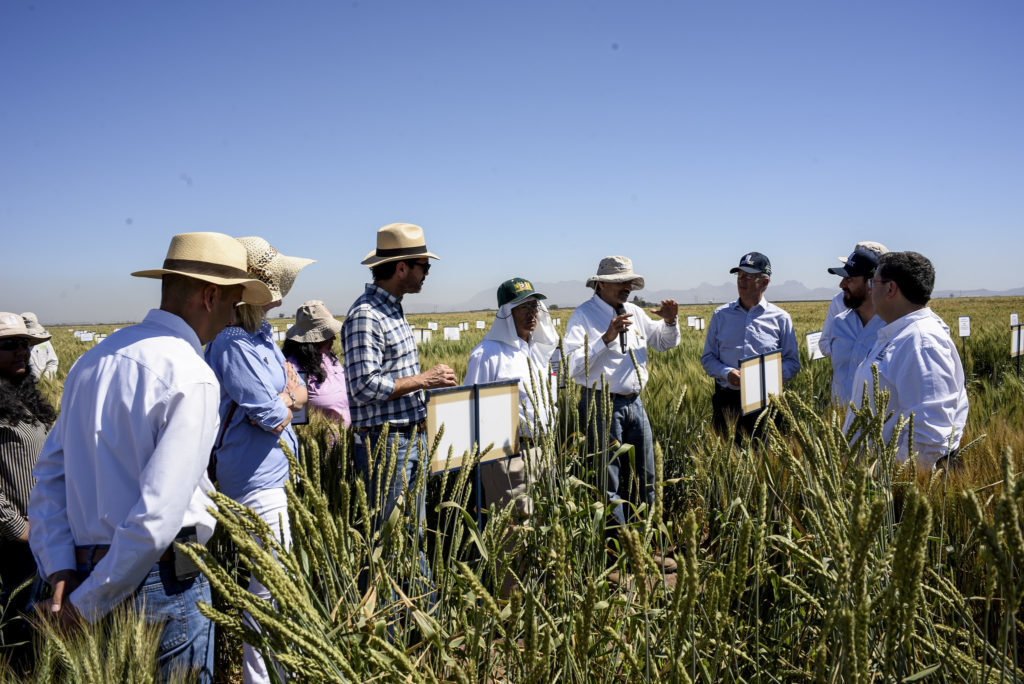
Two complementary networks — the Heat and Drought Wheat Improvement Consortium (HeDWIC) and the International Wheat Yield Partnership (IWYP) — are helping to meet the future demand for wheat consumption through global collaboration and technological partnership.
By harnessing the latest technologies in crop physiology, genetics and breeding, network researchers support the development of new varieties that aim to be more climate resilient, in the case of HeDWIC and with higher yield potential, in the case of IWYP.
These novel approaches to collaboration take wheat research from the theoretical to the practical and incorporate science into real-life breeding scenarios. Methods such as screening genetic resources for physiological traits related to radiation use efficiency and identifying common genetic bases for heat and drought adaptation are leading to more precise breeding strategies and more data for models of genotype-by-environment interaction that help build new plant types and experimental environments for future climates.
IWYP addresses the challenge of raising the genetic wheat yield potential of wheat by up to 50 percent in the next two decades. Achieving this goal requires a strategic and collaborative approach to enable the best scientific teams from across the globe to work together in an integrated program. TheIWYP model of collaboration fosters linkages between ongoing research platforms to develop a cohesive portfolio of activities that maximizes the probability of impact in farmers’ fields IWYP research uses genomic selection to complement the crossing of complex traits by identifying favorable allele combinations among progeny. The resulting products are delivered to national wheat programs worldwide through the IWIN international nursery system.
Recently, IWYP research achieved genetic gains through the strategic crossing of biomass and harvest index — source and sink — an approach that also validates the feasibility of incorporating exotic germplasm into mainstream breeding efforts.
In the case of HeDWIC, intensified — and possibly new — breeding strategies are needed to improve the yield potential of wheat in hotter and drier environments. This also requires a combined effort, using genetic diversity with physiological and molecular breeding and bioinformatic technologies, along with the adoption of improved agronomic practices by farmers. The approach already has proof of concept in the release and adoption of three heat and drought tolerant lines in Pakistan.
It is imperative to build increased yield and climate-resilience to into future germplasm in order to avoid the risk of climate-related crop failure and to maintain global food security in a warmer climate. Partnerships like HeDWIC and IWYP give hope to meeting this urgent food security challenge.
Further readings:
https://www.hedwic.org/resources.htm
https://royalsocietypublishing.org/doi/full/10.1098/rspb.2012.2190
An economist’s perspective on plant sciences: Under-appreciated, over-regulated and under-funded
By Atsuko Kanazawa, Igor Houwat, Cynthia Donovan
This article is reposted with permission from the Michigan State University team. You can find the original post here: MSU-DOE Plant Research Laboratory
Atsuko Kanazawa is a plant scientist in the lab of David Kramer. Her main focus is on understanding the basics of photosynthesis, the process by which plants capture solar energy to generate our planet’s food supply.
This type of research has implications beyond academia, however, and the Kramer lab is using their knowledge, in addition to new technologies developed in their labs, to help farmers improve land management practices.
One component of the lab’s outreach efforts is its participation in the Legume Innovation Lab (LIL) at Michigan State University, a program which contributes to food security and economic growth in developing countries in Sub-Saharan Africa and Latin America.
Atsuko recently joined a contingent that attended a LIL conference in Burkina Faso to discuss legume management with scientists from West Africa, Central America, Haiti, and the US. The experience was an eye opener, to say the least.
To understand some of the challenges faced by farmers in Africa, take a look at this picture, Atsuko says.
“When we look at corn fields in the Midwest, the corn stalks grow uniformly and are usually about the same height,” Atsuko says. “As you can see in this photo from Burkina Faso, their growth is not even.”
“Soil scientists tell us that much farmland in Africa suffers from poor nutrient content. In fact, farmers sometimes rely on finding a spot of good growth where animals have happened to fertilize the soil.”
Even if local farmers understand their problems, they often find that the appropriate solutions are beyond their reach. For example, items like fertilizer and pesticides are very expensive to buy.
That is where USAID’s Feed the Future and LIL step in, bringing economists, educators, nutritionists, and scientists to work with local universities, institutions, and private organizations towards designing best practices that improve farming and nutrition.
Atsuko says, “LIL works with local populations to select the most suitable crops for local conditions, improve soil quality, and manage pests and diseases in financially and environmentally sustainable ways.”
At the Burkina Faso conference, the Kramer lab reported how a team of US and Zambian researchers are mapping bean genes and identifying varieties that can sustainably grow in hot and drought conditions.
The team is relying on a new technology platform, called PhotosynQ, which has been designed and developed in the Kramer labs in Michigan.
PhotosynQ includes a hand-held instrument that can measure plant, soil, water, and environmental parameters. The device is relatively inexpensive and easy to use, which solves accessibility issues for communities with weak purchasing power.
The heart of PhotosynQ, however, is its open-source online platform, where users upload collected data so that it can be collaboratively analyzed among a community of 2400+ researchers, educators, and farmers from over 18 countries. The idea is to solve local problems through global collaboration.
Atsuko notes that the Zambia project’s focus on beans is part of the larger context under which USAID and LIL are functioning.
“From what I was told by other scientists, protein availability in diets tends to be a problem in developing countries, and that particularly affects children’s development,” Atsuko says. “Beans are cheaper than meat, and they are a good source of protein. Introducing high quality beans aims to improve nutrition quality.”
But, as LIL has found, good science and relationships don’t necessarily translate into new crops being embraced by local communities.
Farmers might be reluctant to try a new variety, because they don’t know how well it will perform or if it will cook well or taste good. They also worry that if a new crop is popular, they won’t have ready access to seed quantities that meet demand.
Sometimes, as Atsuko learned at the conference, the issue goes beyond farming or nutrition considerations. In one instance, local West African communities were reluctant to try out a bean variety suggested by LIL and its partners.
The issue was its color.
“One scientist reported that during a recent famine, West African countries imported cowpeas from their neighbors, and those beans had a similar color to the variety LIL was suggesting. So the reluctance was related to a memory from a bad time.”
This particular story does have a happy ending. LIL and the Burkina Faso governmental research agency, INERA, eventually suggested two varieties of cowpeas that were embraced by farmers. Their given names best translate as, “Hope,” and “Money,” perhaps as anticipation of the good life to come.
Another fruitful, perhaps more direct, approach of working with local communities has been supporting women-run cowpea seed and grain farms. These ventures are partnerships between LIL, the national research institute, private institutions, and Burkina Faso’s state and local governments.
Atsuko and other conference attendees visited two of these farms in person. The Women’s Association Yiye in Lago is a particularly impressive success story. Operating since 2009, it now includes 360 associated producing and processing groups, involving 5642 women and 40 men.
“They have been very active,” Atsuko remarks. “You name it: soil management, bean quality management, pest and disease control, and overall economic management, all these have been implemented by this consortium in a methodical fashion.”
“One of the local farm managers told our visiting group that their crop is wonderful, with high yield and good nutrition quality. Children are growing well, and their families can send them to good schools.”
As the numbers indicate, women are the main force behind the success. The reason is that, usually, men don’t do the fieldwork on cowpeas. “But that local farm manager said that now the farm is very successful, men were going to have to work harder and pitch in!”
Back in Michigan, Atsuko is back to the lab bench to continue her photosynthesis research. She still thinks about her Burkina Faso trip, especially how her participation in LIL’s collaborative framework facilitates the work she and her colleagues pursue in West Africa and other parts of the continent.
“We are very lucky to have technologies and knowledge that can be adapted by working with local populations. We ask them to tell us what they need, because they know what the real problems are, and then we jointly try to come up with tailored solutions.”
“It is a successful model, and I feel we are very privileged to be a part of our collaborators’ lives.”
This article is reposted with permission from the Michigan State University team. You can find the original post here: MSU-DOE Plant Research Laboratory
This post was written by Dr Colin Khoury. Colin studies diversity in the crops people grow and eat worldwide, and the implications of change in this diversity on human health and environmental sustainability. He is particularly interested in the wild relatives of crops. Colin is a research scientist at the International Center for Tropical Agriculture (CIAT), Colombia, and at the USDA National Laboratory for Genetic Resources Preservation in Fort Collins, Colorado.
New Changing Global Diet website explores changes in diets over the past 50 years in countries around the world.
One of the central concepts that unifies those concerned with biodiversity is the understanding that this diversity is being lost, piece by piece, to a greater or lesser degree, globally.
The same goes for the biodiversity of what we eat. Scientists and activists have worried about the loss of crops and their many traditional varieties for at least a hundred years, since botanist N. I. Vavilov traveled the world in search of plants useful for cultivation in his Russian homeland. He noticed that diversity was disappearing in the cradles of agriculture – places where crops had been cultivated continuously for thousands of years. The alarm sounded even louder 50 years ago, during the Green Revolution, when farmers in some of the most diverse regions of the world largely replaced their many locally adapted wheat, rice and other grain varieties with fewer, more uniform, higher yielding professionally bred varieties.
(Click to magnify)
This is ironic, since modern productive crop varieties are bred by wisely mixing and matching diverse genetic resources. The disappearance of old varieties thus reduces the options available to plant breeders, including those working to produce more nutritious or resilient crops.
Being a food biodiversity scientist, I grew up (in the professional sense) with the loss of crop diversity looming over my head, providing both a raison d’être, and an urgency to my efforts. Somewhere along the line, I became interested in understanding its magnitude. That is, counting how many crops and how many varieties have been lost.
That’s where it started to become complicated, and also more interesting. Because, when I went looking for signs of the loss of specific crops, I couldn’t find any. Instead, I found evidence of massive global changes in our food diversity that left me worried, but at the same time hopeful.
A bit of background. Most of the numbers seen in the news on how much crop diversity has been lost go back to a handful of reports and books that reference a few studies: for example, the changing number of vegetable varieties for sale in the U.S. over time. The results are estimations for a few crops at local to national levels, but they somehow have been inflated to generalized statements about the global state of crop diversity, the most common of which being some variation of “75% of diversity in crops has been lost”.
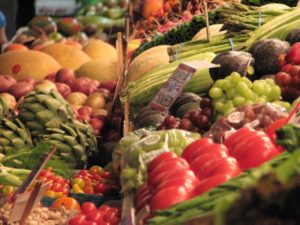
Diverse produce, but is it all local? Image credit: Karyn Christner. Used under license: CC BY 2.0.
Putting true numbers on diversity loss turns out to be a complicated and contested business, with no shortage of strong opinions. One big part of the problem is that there aren’t many good ways to count the diversity that existed before it disappeared. Researchers have done some work to assess the changes in diversity in crop varieties of Green Revolution cereals, and to some degree on the genetic diversity within those varieties. The results indicate that, although diversity on farms decreased when farmers first replaced traditional varieties with modern types, the more recent trends are not so simple to decipher.
It was particularly surprising to me that very little work had been done to understand the changes in what is probably the simplest level to measure: the diversity of crop species in the human diet, that is, how successful is maize versus rice versus potato versus quinoa and so on. I realized that data on the contribution of crops to national food supplies were available for almost all countries worldwide via FAOSTAT, with information for every year since 1961. Perhaps these were the data that could show when a crop fell off the world map.
Fast forward through a couple of years of investigation. To my great surprise, I found that not a single crop was lost over the past 50 years! There was no evidence for extinction. What was going on?

Maize is a key crop in many countries. Image credit: Erfan A. Setiawan. Used under license: CC BY 2.0.
It turns out that my failure to see any loss of crops was due to the lack of sufficient resolution in the FAO data. Only 52 meaningful crop species-specific commodities are measured and a number of these are general groupings such as “cereals, other”. Because of this lack of specificity, the data couldn’t comprehensively assess the crops that have been most vulnerable to changes in the global food system over the past 50 years. In FAO data, these plants are either thrown into the general categories or they aren’t measured at all, especially if they are produced only on a small scale, for local markets or in home gardens. This is, in itself, sign enough that they may be imperiled. We need better statistics about what people eat (and grow) around the world. But, enough is known to be confident that many locally relevant crops are in decline.
Over the past 50 years, almost all countries’ diets actually became more diverse, not less, for the crops that FAO statistics do report on. We found that traditional diets that were primarily based on singular staples a half century ago, for instance rice in Southeast Asia, had diversified over time to include other staples such as wheat and potatoes. The same was true for maize-based diets in Latin America, sorghum- and millet-based diets in sub-Saharan Africa, and so on.
Not that there weren’t plant winners and losers. Wheat, rice, and maize, the most dominant crops worldwide 50 years ago, became more important globally. Other crops emerged as widespread staples, particularly oilcrops such as soybean, palm oil, sunflower, and rapeseed oil. And, as the winners came to take more precedence in food supplies around the world, alternative staples such as sorghum, millets, rye, cassava, sweet potato, and yam were marginalized. They haven’t disappeared (at least not yet), but they have become less important to what is eaten every day.
As countries’ food supplies became more diverse in the winner crops reported by FAO, and the relative abundance of these crops within diets became more even, food supplies worldwide became much more similar, with an average decrease in variation between diets in different countries of 68.8% over the past 50 years!
This is why, although we could see no absolute loss in crops consumed over the past 50 years, I am concerned. For even in the relatively small list of crops reported in the FAO data, many of these foods are becoming marginalized, day by day, bite by bite. That doesn’t seem like a good thing for the long-term resilience of our agricultural areas, nor for human health, although it’s important to remember that such changes are the collateral damage resulting from the creation of highly productive mega-crop farming systems, which have increased the affordability of these foods worldwide, leading to less stunting and other effects of undernutrition worldwide. On the other hand, global dependence on a few select crops equates to expansive monocultures, with more lives riding on the outcome of the game of cat and mouse between pestilence and uniform varieties grown over large areas. Moreover, cheaply available macronutrients have contributed to the negative effects of the nutrition transition, including obesity, heart disease and diabetes.
So why then am I hopeful? Because the data, and some literature, and my own direct experience also indicate that diets in recent years, in some countries, are beginning to move in different directions, reducing the excessive use of animal products and other energy-dense and environmentally expensive foods, and becoming more diverse, particularly with regard to fruits and vegetables, and even healthy grains. What better evidence than quinoa, which was relatively unknown outside the Andes a couple of decades ago, and is now cultivated in 100 countries and consumed in even more?
When we published our findings of increasing homogeneity in global food supplies, we hadn’t yet found a good way to make the underlying national-level data readily visible to interested readers. This is why I’m tremendously excited to announce the publication of our new Changing Global Diet website, which provides interactive visuals for 152 countries over 50 years of change. We that hope you will enjoy your own investigations of dietary change over time. Perhaps you can tell us where you think the changing global diet is headed.
Check out The Changing Global Diet website
Read the published article: Khoury CK, Bjorkman AD, Dempewolf H, Ramírez-Villegas J, Guarino L, Jarvis A, Rieseberg LH and Struik PC (2014). Increasing homogeneity in global food supplies and the implications for food security. PNAS 111(11): 4001-4006.
This week’s blog post was written by Dr Damiano Martignago, a genome editing specialist at Rothamsted Research.
Genome editing technologies comprise a diverse set of molecular tools that allow the targeted modification of a DNA sequence within a genome. Unlike “traditional” breeding, genome editing does not rely on random DNA recombination; instead it allows the precise targeting of specific DNA sequences of interest. Genome editing approaches induce a double strand break (DSB) of the DNA molecule at specific sites, activating the cell’s DNA repair system. This process could be either error-prone, thus used by scientists to deactivate “undesired” genes, or error-free, enabling target DNA sequences to be “re-written” or the insertion of DNA fragments in a specific genomic position.
The most promising among the genome editing technologies, CRISPR/Cas9, was chosen as Science’s 2015 Breakthrough of the Year. Cas9 is an enzyme able to target a specific position of a genome thanks to a small RNA molecule called guide RNA (gRNA). gRNAs are easy to design and can be delivered to cells along with the gene encoding Cas9, or as a pre-assembled Cas9-gRNA protein-RNA complex. Once inside the cell, Cas9 cuts the target DNA sequence homologous to the gRNAs, producing DSBs.

The guide RNA (sgRNA) directs Cas9 to a specific region of the genome, where it induces a double-strand break in the DNA. On the left, the break is repaired by non-homologous-end joining, which can result in insertion/deletion (indel) mutations. On the right, the homologous-directed recombination pathway creates precise changes using a supplied template DNA. Credit: Ran et al. (2013). Nature Protocols.
Together with the increased data availability on crop genomes, genome editing techniques such as CRISPR are allowing scientists to carry out ambitious research on crop plants directly, building on the knowledge obtained during decades of investigation in model plants.
The concept of CRISPR was first tested in crops by generating cultivars that are resistant to herbicides, as this is an easy trait to screen for and identify. One of the first genome-edited crops, a herbicide-resistant oilseed rape produced by Cibus, has already been grown and harvested in the USA in 2015.

Researchers used CRISPR to engineer a wheat variety resistant to powdery mildew (shown here), a major disease of this crop. Image credit: NY State IPM Program. Used under license: CC BY 2.0.
Using CRISPR, scientists from the Chinese Academy of Sciences produced a wheat variety resistant to powdery mildew, one of the major diseases in wheat. Similarly, another Chinese research group exploited CRISPR to produce a rice line with enhanced rice blast resistance that will help to reduce the amount of fungicides used in rice farming. CRISPR/Cas9 has also been already applied to maize, tomato, potato, orange, lettuce, soybean and other legumes.
Genome editing could also revolutionize the management of viral plant disease. The CRISPR/Cas9 system was originally discovered in bacteria, where it provided them with molecular immunity against viruses, but it can also be moved into plants. Scientists can transform plants to produce the Cas9 and gRNAs that target viral DNA, reducing virus accumulation; alternatively, they can suppress those plant genes that are hijacked by the virus to mediate its own diffusion in the plants. Since most plants are defenseless against viruses and there are no chemical controls available for plant viruses, the main method to stop the spread of these diseases is still the destruction of the infected plant. For the first time in history, scientists have an effective weapon to fight back against plant viruses.

The cassava brown streak disease virus can destroy cassava crops, threatening the food security of the 300 million people who rely on this crop in Africa. Image credit: Katie Tomlinson (for more on this topic, read her blog here).
Genome editing will be particularly useful in the genetic improvement of many crops that are propagated mainly by vegetative reproduction, and so very difficult to improve by traditional breeding methods involving crossing (e.g. cassava, banana, grape, potato). For example, using TALENs, scientists from Cellectis edited a potato line to minimize the accumulation of reducing sugars that may be converted into acrylamide (a possible carcinogen) during cooking.
One of the hypothesized risks of using CRISPR/Cas9 is the potential targeting of undesired DNA regions, called off-targets. It is possible to limit the potential for off-targets by designing very specific gRNAs, and all of the work published so far either did not detect any off-targets or, if detected, they occurred at a very low frequency. The number of off-target mutations produced by CRISPR/Cas9 is therefore minimal, especially if compared with the widely accepted random mutagenesis of crops used in plant breeding since the 1950s.
Genome editing is interesting from a regulatory point of view too. After obtaining the desired heritable mutation using CRISPR/Cas9, it is possible to remove the CRISPR/Cas9 integrated vectors from the genome using simple genetic segregation, leaving no trace of the genome modification other than the mutation itself. This means that some countries (including the USA, Canada, and Argentina) consider the products of genome editing on a case-by-case basis, ruling that a crop is non-GM when it contains gene combinations that could have been obtained through crossing or random mutation. Many other countries are yet to issue an official statement on CRISPR, however.
Recently, scientists showed that is possible to edit the genome of plants without adding any foreign DNA and without the need for bacteria- or virus-mediated plant transformation. Instead, a pre-assembled Cas9-gRNA ribonucleoprotein (RNP) is delivered to plant cells in vitro, which can edit the desired region of the genome before being rapidly degraded by the plant endogenous proteases and nucleases. This non-GM approach can also reduce the potential of off-target editing, because of the minimal time that the RNP is present inside the cell before being degraded. RNP-based genome editing has been already applied to tobacco plants, rice, and lettuce, as well as very recently to maize.
In conclusion, genome editing techniques, and CRISPR/Cas9 in particular, offers scientists and plant breeders a flexible and relatively easy approach to accelerate breeding practices in a wide variety of crop species, providing another tool that we can use to improve food security in the future.
For more on CRISPR, check out this recent TED Talk from Ellen Jorgensen:
Dr Damiano Martignago is a plant molecular biologist who graduated from Padua University, Italy, with a degree in Food Biotechnology in 2009. He obtained his PhD in Biology at Roma Tre University in 2014. His experience with CRISPR/Cas9 began in the lab of Prof. Fabio Fornara (University of Milan), where he used CRISPR/Cas9 to target photoperiod genes of interest in rice and generate mutants that were not previously available. He recently moved to Rothamsted Research, UK, where he works as Genome Editing Specialist, transferring CRISPR/Cas9 technology to hexaploid bread wheat with the aim of improving the efficiency of genome editing in this crop. He is actively involved with AIRIcerca (International Association of Italian Scientists), disseminating and promoting scientific news.
Established GM technologies are far from perfect
The first genetically modified (GM) crops were approved for commercial use in 1994, and GM crops are now grown on over 180 million hectares across 29 countries. The most used forms of genetic modification are systems that result in herbicide resistance or expression of the Bt toxin in maize and cotton to provide protection against pests such as the European corn borer. These systems both require few novel genes to be introduced to the plant, and allow more efficient use of herbicides and pesticides, both of which are harmful to the environment and human health. Current systems of genetic modification usually involve
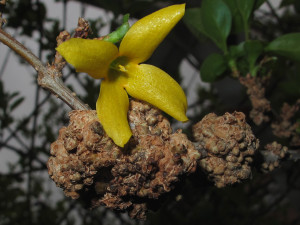
Agrobacterium tumefaciens is used to genetically engineer plants in the lab. In nature this bacteria uses its ability to alter plant DNA to cause tumours. Image by Jacinta Lluch Valero used under Creative Commons 2.0.
the use of Agrobacterium vectors, direct transformation by DNA uptake into the plant protoplast, or bombardment with gold particles covered in DNA. However, current systems of transformation are far from perfect. Many beneficial traits such as disease resistance require stacking of multiple genes, something that is difficult with current transformation systems. Furthermore, it is essential that transgenes are positioned correctly within the host genome. Current systems of genetic modification can insert genes into the ‘wrong’ place, disrupting function of endogenous genes or having implications for down or upstream processes. An additional problem is that transfer of transgenes from one line to another requires several generations of backcrossing. However, the past two decades have seen great developments in microbiology. Many new tools and resources are now available that could greatly enhance the biotechnology of the future.
New technologies
Many new and emerging technologies are now available that could transform plant genetic engineering. For example, high throughput sequencing and the wide availability of bioinformatics tools now make identifying target genes and traits easier than ever. Technologies such as site-specific recombination (SSR) and genome editing allow specific regions of the genome to be precisely targeted in order to add or remove genes. Artificial chromosome technology is also part of this emerging group that could be of benefit to plant science. Synthetic chromosomes have already been used in yeast, and widely studied in mammalian systems due to their potential use in gene therapy. Although there have so far been no definitive examples in plants, work has been done in maize that shows the potential of the technology for use in GM crops.
Building an artificial chromosome
A minichromosomes is a small, synthetic chromosome with no genes of its own. It can be programmed to express any desirable DNA sequence that could encode for one, or a number, of genes. An ideal minichromosome would be small and only contain essential elements such as a centromere, telomeres and origin of replication. Once introduced into the plant the minichromosomes should be designed such that interference with host growth and development is minimal. A key requirement is that the chromosome is stable during both meiosis and mitosis. This would ensure introduced genes do not become disrupted or mutated during cell division and reproduction. Gene expression would therefore remain the same for many generations. Finally, the DNA sequence on the minichromosomes could be designed such that it is amenable to SSR or gene editing systems. This would allow re-design and addition of new traits further down the line.
Potential advantages of artificial chromosomes
Plant artificial chromosomes (PACs) have many advantages over traditional transformation systems. For example, to confer complex traits such as disease resistance and tolerance to abiotic stresses such as heat and drought, multiple genes are required. This is not easy with current methods of modification.
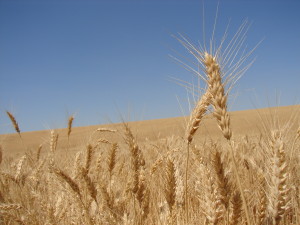
PACs could offer a new way to introduce beneficial traits to our crops plants and feed a growing population.Image by Seattle.Romer. Used under Creative Commons 2.0.
However, PACs allow an almost unlimited number of genes to be integrated into the host system. A further possibility that comes from being able to add multiple genes is the addition of new metabolic pathways into the plant. This could allow us to change the nutrients produced by a plant to benefit our diets. Additionally, in a contained environment, plants could be used as a cheap, sustainable way to produce pharmaceuticals. A second major benefit of PACs is that they avoid linkage drag. This is when a desirable gene is closely linked to a deleterious gene that acts to reduce plant fitness. Where this linkage is very tight even repeated backcrossing cannot separate out the genes. Design of new DNA sequences completely avoids this problem, and could allow us to select out detrimental traits from out crop plants.
Regulations for novel biotechnology
Emerging technologies pose new questions to policy makers regarding GM regulation. For example, the use of genome editing, whereby specific sites in the genome are targeted and modified, produces an end product with a phenotype almost identical to one that could be achieved through conventional breeding. This sets genome-edited crops apart from other transgene-containing GM material. For this reason many now argue that genome-edited crops ought not to come under current GM regulations. Much of this argument centres on whether or not to regulate the scientific technique used to produce a crop, or to regulate the end product in the field. For more information on genome editing including current regulations and consensus, see the links at the end of this article.
PACs pose a different set of problems entirely. Minichromosomes would be foreign bodies in the plant, and gene stacking within these introduces even more foreign genes than is possible with current technologies. This would require extensive assessment of both environmental and health effects prior to commercialization. Currently regulatory approval costs around $1-15 million per insertion into the genome. These heavy charges may discourage the further development of minichromosomes technology. However, with PACs it is possible that a particular package of genes could be assessed once, and then transferred into numerous cultivars. This would eliminate the requirement to individually engineer and test every cultivar, so perhaps saving time and money in the long term.
More information on genome editing:
Sense about science genome editing Q & A
The regulatory status of genome-edited crops
The Guardian article on genome editing regulation
A proposed regulatory network for genome edited crops in Nature
A recent workshop on the CRISPR-CAS system of genome editing was held in September 2015 by GARNet and OpenPlant at the John Innes Centre in Norwich, UK. You can read the full meeting report here.
Herbivorous pests can devastate crops, with huge economic and social impacts that threaten global food security. In 2011 scientists warned that biological threats, including pests and pathogens, account for a 40% loss in global production and have the potential for even higher losses in the future.

A farmer sprays pesticides on her crop. From IFPRI – IMAGES. Used under Creative Commons 2.0.
In the 1950s and 1960s huge amounts of pesticides were being used in agriculture, with negative effects on both humans and ecology. Pests and pathogens were developing resistance to pesticides, and to counteract this chemical companies were developing ever stronger, more expensive chemicals.
Perry Adkisson and Ray Smith, both entomologists, noted the harmful effects on the economy and environment of the overuse of synthetic pesticides. Working together they identified practical approaches to pest control that minimized pesticide use. They developed and popularized integrated pest management (IPM) systems, for which they won the World Food prize in 1997.
“Integrated Pest Management (IPM) means the careful consideration of all available pest control techniques and subsequent integration of appropriate measures that discourage the development of pest populations and keep pesticides and other interventions to levels that are economically justified and reduce or minimize risks to human health and the environment. IPM emphasizes the growth of a healthy crop with the least possible disruption to agro-ecosystems and encourages natural pest control mechanisms.” FAO definition
What is IPM?
IPM is an approach to crop production that considers the whole ecosystem, integrating a number of management techniques, rather than focusing all resources on a single practice such as pesticide use. Adkisson and Smith identified a number of principals around which successful IPM should be based:
Firstly, crop varieties should be selected that are appropriate to the culture and local environment. This would ensure the crop species is already adapted to local conditions, and may have some defense mechanisms to protect itself from biotic and abiotic stresses.
Secondly, IPM is based around pest control rather than complete eradication. Therefore, maximum tolerable levels of the pest that still enable good crop yields should be identified and the pests should be allowed to survive at this threshold level, although allowing a number of pests to exist within the crop requires continual monitoring. Good knowledge of pest behavior and lifecycle enables the prediction of where more or less controls are required.
Finally, when choosing a method of control, both mechanical methods, such as traps or barriers, or appropriate biological control are preferential. However, pesticides can be integrated into the plan if necessary, providing use is responsible and not in excess of requirements. Some really cool practices are now emerging that can be used as part of an IPM system around the world.
Enhancing biological control
Simply reducing pesticide use can actually lead to increased yields, as farmers in Vietnam discovered when scientists convinced them to try it for themselves. Their nemesis, the brown planthopper (Nilaparvata lugens), is increasingly resistant to insecticides, with devastating outbreaks becoming more common. Rice farmers found that by stopping their typical regular insecticide sprays, the planthopper’s natural predators such as frogs, spiders, wasps and dragonflies were able to survive and remove the pests, giving farmers a 10% increase in harvest income. This improved biological control is a key component of IPM.
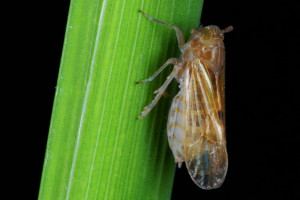
The Brown Planthopper (Nilaparvata lumens) on a rice stem. From IRRI photos. Used under Creative Commons 2.0.
Push-pull technology
Push-pull agriculture has been very successful in Kenya, where stemborer moths can cause vast yield losses in maize with estimated economic impacts of up to US$ 40.8 million per year. Push-pull technology uses selected species as intercrops between the main crops of interest. Intercrops work in two ways, by pushing pests away from the economically valuable crop, and pulling them towards a less valuable intercrop. The stemborer moth push-pull system uses Desmodium (Desmodium uncinatum) to repel stemborer moths. Desmodium species are small flowering plants that produce secondary metabolites that repel insects. Moths are then attracted to the surrounding napier grass instead.
Aside from controlling the stemborer moth, this system has a number of additional benefits. Desmodium suppresses the growth of Striga grass (a devastating weed that you can read about here) via a number of mechanisms, primarily through interfering with root growth. Additionally, the intercrop species can be used for animal fodder and improve soil fertility. The multiple benefits and success of this system has meant push pull has now been adopted by over 80,000 small-holdings in Kenya and is being rolled out to Uganda, Tanzania and Ethiopia.
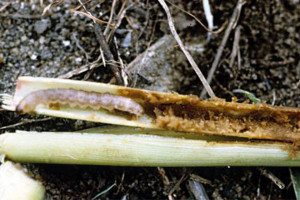
Stem borer larva feeding on a maize stem. From International Institute of Tropical Agriculture. Used under Creative Commons 2.0.
Abrasive weeding
Abrasive weeding is a relatively new technique that involves firing air-propelled grit at a crop to physically kill any weeds growing between crop rows. One issue with this method is that it indiscriminately damages the stem and leaf tissue of both crops and weeds, but grit applicator nozzles are available to more directly target the base of the stem to minimize collateral damage. A recent study found abrasive weed control reduced weed density by up to 80% in tomato and pepper fields, with 33-44% increases in yield.
Maize cob or walnut shells are currently the most frequently used grits, but the technique offers the exciting possibility of combining fertilization and weed control in one step, which could reduce time and cost to the farmer. For example, soybean meal is able to destroy plant tissues when fired from the gun, and has high nitrogen content that is released slowly into the soil over a period of at least three months, making it an ideal source of fertilizer.
The global population is projected to reach 9.6 billion by 2050, and to accommodate this, crop production must increase by 60% in the next 35 years. Furthermore, our global climate is rapidly changing, putting our cropping systems under more strain than ever before. Agriculture will need to adapt to accommodate more extreme weather events and changing conditions that may mean increased instance of drought, heatwaves or flooding. The Global Plant Council Stress Resilience initiative, was created to address these issues.
Back in October the Global Plant Council, in collaboration with the Society for Experimental Biology brought together experts from around the world at a Stress Resilience Forum to identify gaps in current research, and decide how best the plant science community can move forwards in terms of developing more resilient agricultural systems. We interviewed a number of researchers throughout the meeting, asking about their current work and priorities for the future. Watch the best bits in the video below: